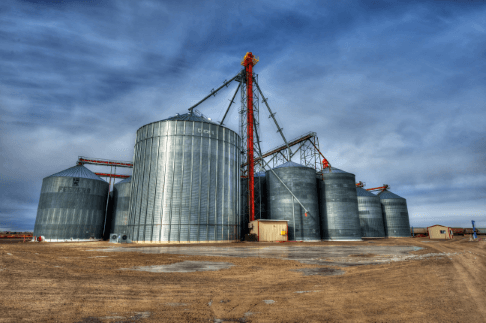Grain storage tends to be the most dangerous potential hazard in the agricultural industry. Farmworkers can easily become entrapped in these bins when inspecting, breaking up, or unloading various agricultural products. The U.S. sees around 15 to 20 grain bin-related entrapments a year. When the grain is released from the container or begins shifting inside the bin, workers may be entrapped in a matter of seconds, leading to suffocation and even death.
If your facility or business handles large volumes of agricultural products, use this grain bin safety information to prevent injuries and on-the-job fatalities.
SAFETY PRECAUTIONS FOR ENTERING A GRAIN BIN
You and your team should only enter a grain bin when absolutely necessary and avoid doing so whenever possible. Never enter a bin when the grain is flowing, as grain entrapment can easily occur. However, you may need to enter a bin from time to time to break up the grain or inspect the quality of the product. Take these precautions before entering the container:
- Try breaking up the grain with a long pole before entering the container, while keeping it away from electrical lines. You should never try breaking up large stacks of grain while standing inside the container, as it may suddenly topple over you.
- Wear a harness and make sure it is properly secured before stepping inside the bin. Keep one or preferably two workers nearby that can help you out in case of an emergency. They should be fully trained on the latest bin rescue protocols.
- Stay near the outer edges of the bin and avoid walking in the center.
- If the grain starts to flow or shift beneath your feet, continue walking to avoid getting stuck. Reach for the closest ladder or rope immediately. It’s best to use brightly colored rescue gear to improve visibility.
- Keep unloading equipment locked or away from the bin when entering, so someone doesn’t accidentally turn it on while you’re inside.
- Grain dust can easily irritate the lungs. Wear a respirator to breathe normally when entering the container.
CONSIDER THE MOVEMENT AND FLOW OF THE GRAIN
It’s also important to keep the natural flow of the grain in mind when entering a bin or handling your products. A depreciation will typically form in the middle of the bin when releasing your grain, much like an hourglass. Use a pole to identify any gaps or voids in the buildup of the grain. Vertically crusted grain will quickly flow to the other side when it is broken up with a pole.
HOW GRAIN QUALITY AFFECTS WORKPLACE SAFETY
The quality of your grain can also affect the safety of your workplace. Your team may need to walk up and down the bin more often if they are overly concerned with the quality of your products. Textured and uneven grain may also be more of a hazard in certain situations. Voids and gaps may be more difficult to detect. It’s best to control the fineness of your products as much as possible, so your workers can focus more on grain storage safety and spend less time inspecting the quality of your products.
Use caution when managing or inspecting your grain products. Avoid entering a bin at all costs and work in teams to reduce the chances of error. Contact the professionals at Halverson Company for information on agricultural construction projects or additional bin grain safety information.

